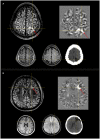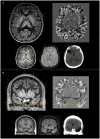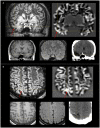Fluid and White Matter Suppression Imaging and Voxel-Based Morphometric Analysis in Conventional Magnetic Resonance Imaging-Negative Epilepsy
- PMID: 33995250
- PMCID: PMC8116947
- DOI: 10.3389/fneur.2021.651592
Fluid and White Matter Suppression Imaging and Voxel-Based Morphometric Analysis in Conventional Magnetic Resonance Imaging-Negative Epilepsy
Abstract
Purpose: Delineation of subtle lesions in magnetic resonance imaging (MRI)-negative patients is of great importance in preoperative epilepsy evaluation. The aim of our study was to explore the diagnostic value of the novel fluid and white matter suppression (FLAWS) sequence in comparison with a voxel-based MRI postprocessing morphometric analysis program (MAP) in a consecutive cohort of non-lesional patients. Methods: Surgical candidates with a negative finding on an official neuroradiology report were enrolled. High-resolution FLAWS image and MAP maps generated based on high-resolution three-dimensional (3D) T1 image were visually inspected for each patient. The findings of FLAWS or MAP-positive (FLAWS/MAP+) regions were compared with the surgical resection cavity in correlation with surgical outcome and pathology. Results: Forty-five patients were enrolled; the pathological examination revealed focal cortical dysplasia (FCD) in 32 patients and other findings in 13 patients. The positive rate, sensitivity, and specificity were 48.9%, 0.43, and 0.87, respectively, for FLAWS and 64.4%, 0.57, and 0.8, respectively, for MAP. Concordance between surgical resection and FLAWS+ or MAP+ regions was significantly associated with a seizure-free outcome (FLAWS: p = 0.002; MAP: p = 0.0003). A positive finding in FLAWS and MAP together with abnormalities in the same gyrus (FLAWS-MAP gyral+) was detected in 31.1% of patients. FLAWS+ only and MAP+ only were found in 7 (15.5%) and 14 (31.1%) patients, respectively. Conclusions: FLAWS showed a promising value for identifying subtle epileptogenic lesions and can be used as a complement to current MAP in patients with MRI-negative epilepsy.
Keywords: MRI post-processing; epilepsy; flaws; focal cortical dysplasia; non-lesional; voxel-based morphometric.
Copyright © 2021 Sun, Yu, Yang, Ren, Qiao, Ni, Wang, Zhao, Chen, Xiang, Chen, Gao, Yang, Lin, Kober and Zhang.
Conflict of interest statement
TK is a full employee of Siemens Healthcare AG Switzerland. The remaining authors declare that the research was conducted in the absence of any commercial or financial relationships that could be construed as a potential conflict of interest.
Figures




Similar articles
-
Gray-matter-specific MR imaging improves the detection of epileptogenic zones in focal cortical dysplasia: A new sequence called fluid and white matter suppression (FLAWS).Neuroimage Clin. 2018 Aug 11;20:388-397. doi: 10.1016/j.nicl.2018.08.010. eCollection 2018. Neuroimage Clin. 2018. PMID: 30128277 Free PMC article.
-
Voxel-based morphometric magnetic resonance imaging postprocessing in non-lesional pediatric epilepsy patients using pediatric normal databases.Eur J Neurol. 2019 Jul;26(7):969-e71. doi: 10.1111/ene.13916. Epub 2019 Mar 12. Eur J Neurol. 2019. PMID: 30685877
-
Morphometric analysis on T1-weighted MRI complements visual MRI review in focal cortical dysplasia.Epilepsy Res. 2018 Feb;140:184-191. doi: 10.1016/j.eplepsyres.2018.01.018. Epub 2018 Jan 31. Epilepsy Res. 2018. PMID: 29414526
-
Utility of MRI, PET, and ictal SPECT in presurgical evaluation of non-lesional pediatric epilepsy.Seizure. 2020 Apr;77:15-28. doi: 10.1016/j.seizure.2019.05.008. Epub 2019 May 11. Seizure. 2020. PMID: 31122814 Free PMC article. Review.
-
Neuroimaging of focal cortical dysplasia.J Neuroimaging. 2006 Jul;16(3):185-96. doi: 10.1111/j.1552-6569.2006.00025.x. J Neuroimaging. 2006. PMID: 16808819 Review.
Cited by
-
Advances in magnetic resonance imaging for the assessment of paediatric focal epilepsy: a narrative review.Transl Pediatr. 2024 Sep 30;13(9):1617-1633. doi: 10.21037/tp-24-166. Epub 2024 Sep 12. Transl Pediatr. 2024. PMID: 39399717 Free PMC article. Review.
-
Making the Invisible Visible: Advanced Neuroimaging Techniques in Focal Epilepsy.Front Neurosci. 2021 Jul 27;15:699176. doi: 10.3389/fnins.2021.699176. eCollection 2021. Front Neurosci. 2021. PMID: 34385902 Free PMC article. Review.
-
Multi T1-weighted contrast imaging and T1 mapping with compressed sensing FLAWS at 3 T.MAGMA. 2023 Oct;36(5):823-836. doi: 10.1007/s10334-023-01071-5. Epub 2023 Feb 27. MAGMA. 2023. PMID: 36847989
-
Diagnostic Accuracy of Epilepsy-dedicated MRI with Post-processing.Clin Neuroradiol. 2023 Sep;33(3):709-719. doi: 10.1007/s00062-023-01265-3. Epub 2023 Mar 1. Clin Neuroradiol. 2023. PMID: 36856785 Free PMC article.
-
Single-slab 3D double inversion recovery for magnetic resonance brain imaging in clinically healthy dogs.Front Vet Sci. 2023 Jul 17;10:1156870. doi: 10.3389/fvets.2023.1156870. eCollection 2023. Front Vet Sci. 2023. PMID: 37529177 Free PMC article.
References
LinkOut - more resources
Full Text Sources
Other Literature Sources
Medical

